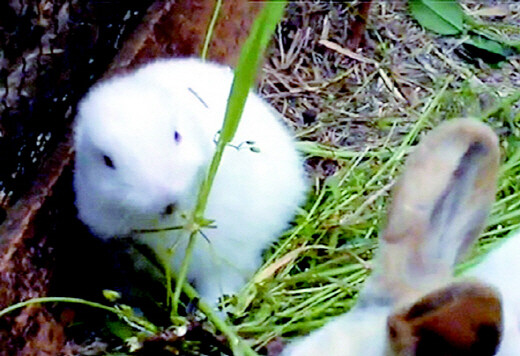hankyoreh
Links to other country sites 다른 나라 사이트 링크
Earless rabbit in Japan bolsters radiation concerns


By Jung Nam-ku, Tokyo Correspondent
On May 21, a Youtube user with the ID of yuunosato posted a video of entitled “Earless Rabbit Born After the Nuclear Accident at Fukushima” (translation). More than 2.35 million people have viewed the video. The white rabbit was born on a farm in Namie, Tsushima and has no ears. The farm is located just over 30km northwest of the Fukushima Daiich Nuclear Power Plant, where an accident led to the release of large amounts of radiation.
Was this really due to the radiation exposure? Japan Offspring Fund, a Japanese civic organization, visited the farm in early July to take samples of the soil near the breeding farm. They detected radioactive materials. In the August issue of its journal, the group ran the results of the study, and said as the mother rabbit gave birth to a deformed bunny after becoming pregnant at the early stage of the nuclear accident, it appeared it was seriously exposed to radiation.
Using as a reference the soil and weed pollution of Itatemura, which currently suffers from a similar degree of pollution as the area where the rabbit was bred, on March 20, when the rabbit’s mother is believed to have become pregnant, levels of Iodine-131 in the grass near the breeding farm are presumed to have been about 992,000Bq/1kg, and cesium 134 and 137 at 690,000Bq/1kg each.
Junichi Kowaka, editor-in-chief of Japan Offspring Fund’s journal, said if we presume the mother rabbit ate 1kg of this polluted grass for four days, its internal radiation exposure would have been 844mSv.
During an interview with the journal, Osaka University Professor Emeritus Daisei Nomura, an authority on the genetic impact of radiation, said, “In lab animals, irregularities in the vertebrae have been discovered after an exposure of just 100mSv.”
Nomura added, “In humans, deformities such as missing fingers begin to appear from exposures beginning at 800 to 1,000mSv.”
Yuko Sugimoto, the owner of the farm, said since he raises rabbits by bringing them together from different parts of the country, there was no chance of inbreeding. After the Chernobyl accident in 1986, too, deformed animals and deformed human babies were born in contaminated areas.
Naturally observers note that radiation exposure for people living in the same area would not be equivalent. This is because the rabbit is presumed to have been exposed after eating contaminated grass, its staple food. However, as radiation began to quickly spread on March 15, and the Japanese government suspended shipment of Fukushima spinach on March 21, the possibility remains that there are people who consumed highly contaminated vegetables.
The Japan Offspring Fund is a non-profit organization formed in 1984, with donations from citizens, to directly study the safety of chemicals added to foodstuffs. In 2004, it received a human rights award from the Tokyo Bar Association.
Please direct questions or comments to [englishhani@hani.co.kr]
Editorial・opinion
![[Column] Park Geun-hye déjà vu in Yoon Suk-yeol [Column] Park Geun-hye déjà vu in Yoon Suk-yeol](https://flexible.img.hani.co.kr/flexible/normal/500/300/imgdb/original/2024/0424/651713945113788.jpg) [Column] Park Geun-hye déjà vu in Yoon Suk-yeol
[Column] Park Geun-hye déjà vu in Yoon Suk-yeol![[Editorial] New weight of N. Korea’s nuclear threats makes dialogue all the more urgent [Editorial] New weight of N. Korea’s nuclear threats makes dialogue all the more urgent](https://flexible.img.hani.co.kr/flexible/normal/500/300/imgdb/original/2024/0424/7317139454662664.jpg) [Editorial] New weight of N. Korea’s nuclear threats makes dialogue all the more urgent
[Editorial] New weight of N. Korea’s nuclear threats makes dialogue all the more urgent- [Guest essay] The real reason Korea’s new right wants to dub Rhee a founding father
- [Column] ‘Choson’: Is it time we start referring to N. Korea in its own terms?
- [Editorial] Japan’s rewriting of history with Korea has gone too far
- [Column] The president’s questionable capacity for dialogue
- [Column] Are chaebol firms just pizza pies for families to divvy up as they please?
- [Column] Has Korea, too, crossed the Rubicon on China?
- [Correspondent’s column] In Japan’s alliance with US, echoes of its past alliances with UK
- [Editorial] Does Yoon think the Korean public is wrong?
Most viewed articles
- 1‘We must say no’: Seoul defense chief on Korean, USFK involvement in hypothetical Taiwan crisis
- 2[Reportage] On US campuses, student risk arrest as they call for divestment from Israel
- 3[Column] Park Geun-hye déjà vu in Yoon Suk-yeol
- 4‘Weddingflation’ breaks the bank for Korean couples-to-be
- 5Korea sees more deaths than births for 52nd consecutive month in February
- 6N. Korean delegation’s trip to Iran shows how Pyongyang is leveraging ties with Moscow
- 7Amnesty notes ‘erosion’ of freedom of expression in Korea in annual human rights report
- 8Will NewJeans end up collateral damage in internal feud at K-pop juggernaut Hybe?
- 9N. Korean hackers breached 10 defense contractors in South for months, police say
- 10[Guest essay] The real reason Korea’s new right wants to dub Rhee a founding father